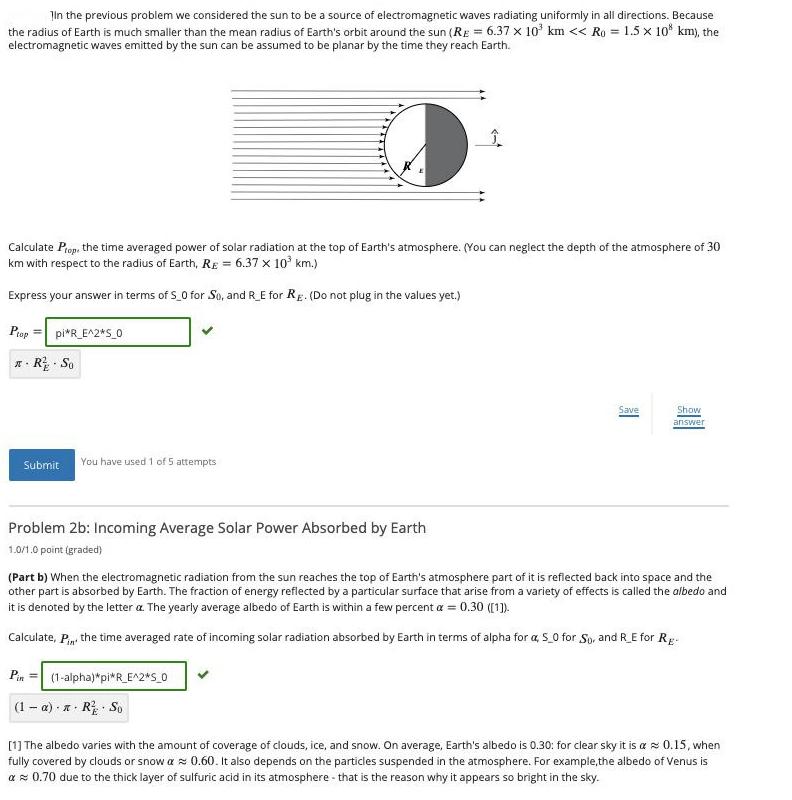Answered step by step
Verified Expert Solution
Question
1 Approved Answer
in the previous problem we considered the sun to be a source of electromagnetic waves radiating uniformly in all directions. Because the radius of


in the previous problem we considered the sun to be a source of electromagnetic waves radiating uniformly in all directions. Because the radius of Earth is much smaller than the mean radius of Earth's orbit around the sun (RE = 6.37 x 10 km < < Ro = 1.5 x 10* km), the electromagnetic waves emitted by the sun can be assumed to be planar by the time they reach Earth. Calculate Prop, the time averaged power of solar radiation at the top of Earth's atmosphere. (You can neglect the depth of the atmosphere of 30 km with respect to the radius of Earth, RE = 6.37 x 10 km.) Express your answer in terms of S_0 for So, and R_E for RE. (Do not plug in the values yet.) Prop pi*R_E^2*S_0 R So Save Show answer Submit You have used 1 of 5 attempts Problem 2b: Incoming Average Solar Power Absorbed by Earth 1.0/1.0 point (graded) (Part b) When the electromagnetic radiation from the sun reaches the top of Earth's atmosphere part of it is reflected back into space and the other part is absorbed by Earth. The fraction of energy reflected by a particular surface that arise from a variety of effects is called the albedo and it is denoted by the letter a The yearly average albedo of Earth is within a few percent a = 0.30 (1). Calculate, P the time averaged rate of incoming solar radiation absorbed by Earth in terms of alpha for a S_0 for So, and RE for Rg- Pin = (1-alpha)"pi*R_E^2*S_0 (1-a),,RSo [1] The albedo varies with the amount of coverage of clouds, ice, and snow. On average, Earth's albedo is 0.30: for clear sky it is a s 0.15, when fully covered by clouds or snow a z 0.60. It also depends on the particles suspended in the atmosphere. For example,the albedo of Venus is a z 0.70 due to the thick layer of sulfuric acid in its atmosphere - that is the reason why it appears so bright in the sky. Problem 2c: Incoming Intensity of the Solar Radiation Absorbed by Earth 0.0/1.0 point (graded) (Part c) From our experience, we know that the daytime side of Earth is warmer than the nighttime side, and it is even warmer at the equator. In our simple model, we will assume Earth is a uniform spherical blackbody that perfectly absorbs incoming solar radiation and radiates it back into space at a temperature Tg. Under this assumption, calculate Iim the intensity of the incoming solar radiation absorbed by Earth. Express your answer in terms of alpha for a and S_0 for Sp- Iin =| (1-alpha)"s 0 (1 - a) So
Step by Step Solution
★★★★★
3.54 Rating (158 Votes )
There are 3 Steps involved in it
Step: 1

Get Instant Access to Expert-Tailored Solutions
See step-by-step solutions with expert insights and AI powered tools for academic success
Step: 2

Step: 3

Ace Your Homework with AI
Get the answers you need in no time with our AI-driven, step-by-step assistance
Get Started


